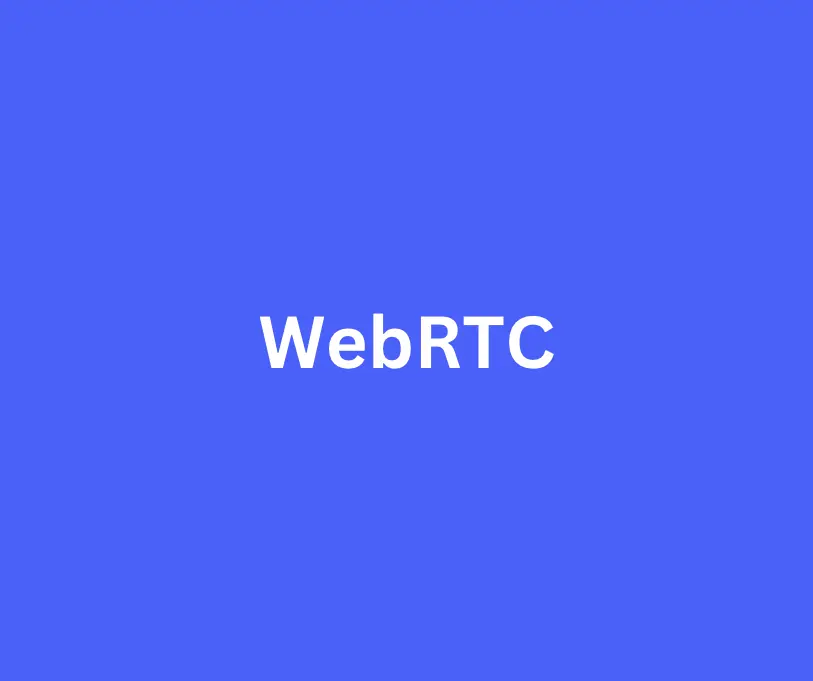· 4 min read
WebRTC
WebRTC is a free, open-source project that enables web browsers and mobile applications to provide real-time communication (RTC) via simple APIs. It includes the fundamental building blocks for high-quality communications such as network, audio, and video components used in voice and video chat applications.

WebRTC (Web Real-Time Communication) is a set of APIs and protocols that enable real-time communication over peer-to-peer connections. It allows audio and video communication and data transfer between devices, such as computers, smartphones, and tablets, without the need for a centralized server. This makes it possible for WebRTC to provide low-latency communication, making it suitable for applications such as voice and video calling, video conferencing, and real-time messaging.
WebRTC is implemented in web browsers and is supported by Google Chrome, Mozilla Firefox, and other modern browsers. It is also supported by native applications on mobile devices, such as smartphones and tablets.
WebRTC is a free, open-source project that is maintained by the World Wide Web Consortium (W3C) and the Internet Engineering Task Force (IETF). It is designed to work across different platforms and devices, making it a popular choice for developers building real-time communication applications.
WebRTC vs WebSocket
WebRTC (Web Real-Time Communication) is a technology that allows for the establishment of real-time communication between web browsers and devices. It enables audio and video communication and data transfer between devices. WebRTC uses a peer-to-peer (P2P) connection, which means that data is transferred directly between devices without the need for a centralized server. This makes it possible for WebRTC to provide low-latency communication, making it suitable for applications such as voice and video calling, video conferencing, and real-time messaging.
WebSocket, on the other hand, is a protocol that enables bidirectional communication between a client (such as a web browser) and a server over a single, long-lived TCP connection. It allows the server to push data to the client in real-time, making it suitable for applications such as online gaming, real-time messaging, and stock tickers. Unlike WebRTC, which uses a P2P connection, WebSocket relies on a centralized server to facilitate communication between clients.
In general, WebRTC is used for real-time communication between devices, while WebSocket is used for real-time communication between a client and a server. Both technologies are widely used and have their own strengths and use cases.
WebRTC Libraries
There are a number of libraries available for working with WebRTC (Web Real-Time Communication), each with its own unique set of features and capabilities. Some popular libraries include:
-
SimpleWebRTC: A JavaScript library that makes it easy to get started with WebRTC. It provides a simple API for creating and maintaining connections, sending and receiving data, and handling events.
-
PeerJS: A JavaScript library that simplifies the process of creating peer-to-peer connections using WebRTC. It provides a high-level API for working with WebRTC, making it easy to get started with real-time communication in web applications.
-
Adorable: A JavaScript library that provides a simple API for creating and managing WebRTC connections. It is designed to be lightweight and easy to use, making it a good choice for developers who want to get started with WebRTC quickly.
-
EasyRTC: A JavaScript library that provides a simple API for creating and managing WebRTC connections. It is designed to be easy to use and is well-suited for developers who are new to WebRTC.
-
OpenWebRTC: A C library that provides a low-level API for working with WebRTC. It is designed to be lightweight and easy to integrate into other applications.
There are many other libraries available for working with WebRTC, and the best choice for a particular project will depend on the specific needs and requirements of the application.
Future of WebRTC
WebRTC has gained widespread adoption and is used in a variety of applications, including voice and video calling, video conferencing, real-time messaging, and more.
In the future, it is expected that WebRTC will continue to evolve and be used in a wider range of applications. One area where it is expected to see growth is in the development of virtual reality (VR) and augmented reality (AR) applications. WebRTC’s low-latency communication capabilities make it well-suited for these types of applications, which require real-time interaction and data transfer.
WebRTC is also expected to continue to be used for traditional communication applications, such as voice and video calling, as well as for new types of applications that have yet to be developed. As the technology continues to evolve and become more widely adopted, it is likely that it will play a significant role in the future of real-time communication on the web.